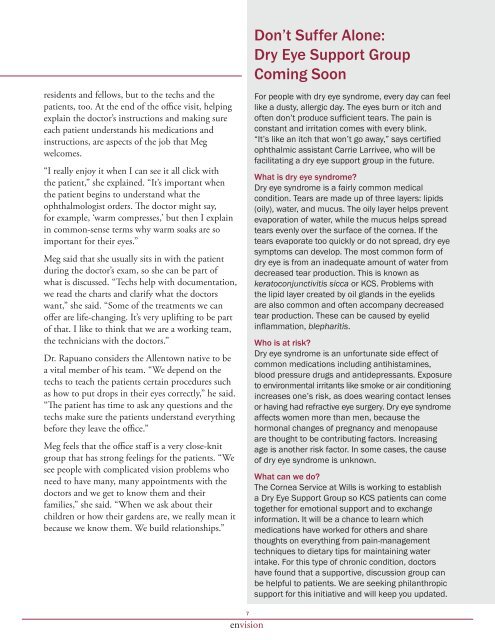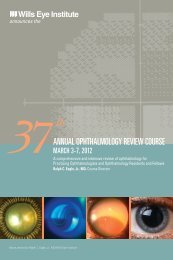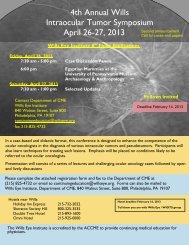Envision Newsletter - Wills Eye
Envision Newsletter - Wills Eye
Envision Newsletter - Wills Eye
Create successful ePaper yourself
Turn your PDF publications into a flip-book with our unique Google optimized e-Paper software.
esidents and fellows, but to the techs and the<br />
patients, too. At the end of the office visit, helping<br />
explain the doctor’s instructions and making sure<br />
each patient understands his medications and<br />
instructions, are aspects of the job that Meg<br />
welcomes.<br />
“I really enjoy it when I can see it all click with<br />
the patient,” she explained. “It’s important when<br />
the patient begins to understand what the<br />
ophthalmologist orders. e doctor might say,<br />
for example, ‘warm compresses,’ but then I explain<br />
in common-sense terms why warm soaks are so<br />
important for their eyes.”<br />
Meg said that she usually sits in with the patient<br />
during the doctor’s exam, so she can be part of<br />
what is discussed. “Techs help with documentation,<br />
we read the charts and clarify what the doctors<br />
want,” she said. “Some of the treatments we can<br />
offer are life-changing. It’s very uplifting to be part<br />
of that. I like to think that we are a working team,<br />
the technicians with the doctors.”<br />
Dr. Rapuano considers the Allentown native to be<br />
a vital member of his team. “We depend on the<br />
techs to teach the patients certain procedures such<br />
as how to put drops in their eyes correctly,” he said.<br />
“e patient has time to ask any questions and the<br />
techs make sure the patients understand everything<br />
before they leave the office.”<br />
Meg feels that the office staff is a very close-knit<br />
group that has strong feelings for the patients. “We<br />
see people with complicated vision problems who<br />
need to have many, many appointments with the<br />
doctors and we get to know them and their<br />
families,” she said. “When we ask about their<br />
children or how their gardens are, we really mean it<br />
because we know them. We build relationships.”<br />
Don’t Suffer Alone:<br />
Dry <strong>Eye</strong> Support Group<br />
Coming Soon<br />
For people with dry eye syndrome, every day can feel<br />
like a dusty, allergic day. the eyes burn or itch and<br />
often don’t produce sufficient tears. the pain is<br />
constant and irritation comes with every blink.<br />
“it’s like an itch that won’t go away,” says certified<br />
ophthalmic assistant Carrie larrivee, who will be<br />
facilitating a dry eye support group in the future.<br />
What is dry eye syndrome?<br />
Dry eye syndrome is a fairly common medical<br />
condition. tears are made up of three layers: lipids<br />
(oily), water, and mucus. the oily layer helps prevent<br />
evaporation of water, while the mucus helps spread<br />
tears evenly over the surface of the cornea. if the<br />
tears evaporate too quickly or do not spread, dry eye<br />
symptoms can develop. the most common form of<br />
dry eye is from an inadequate amount of water from<br />
decreased tear production. this is known as<br />
keratoconjunctivitis sicca or KCS. Problems with<br />
the lipid layer created by oil glands in the eyelids<br />
are also common and often accompany decreased<br />
tear production. these can be caused by eyelid<br />
inflammation, blepharitis.<br />
Who is at risk?<br />
Dry eye syndrome is an unfortunate side effect of<br />
common medications including antihistamines,<br />
blood pressure drugs and antidepressants. exposure<br />
to environmental irritants like smoke or air conditioning<br />
increases one’s risk, as does wearing contact lenses<br />
or having had refractive eye surgery. Dry eye syndrome<br />
affects women more than men, because the<br />
hormonal changes of pregnancy and menopause<br />
are thought to be contributing factors. increasing<br />
age is another risk factor. in some cases, the cause<br />
of dry eye syndrome is unknown.<br />
What can we do?<br />
the Cornea Service at wills is working to establish<br />
a Dry eye Support Group so KCS patients can come<br />
together for emotional support and to exchange<br />
information. it will be a chance to learn which<br />
medications have worked for others and share<br />
thoughts on everything from pain-management<br />
techniques to dietary tips for maintaining water<br />
intake. For this type of chronic condition, doctors<br />
have found that a supportive, discussion group can<br />
be helpful to patients. we are seeking philanthropic<br />
support for this initiative and will keep you updated.<br />
7<br />
envision






